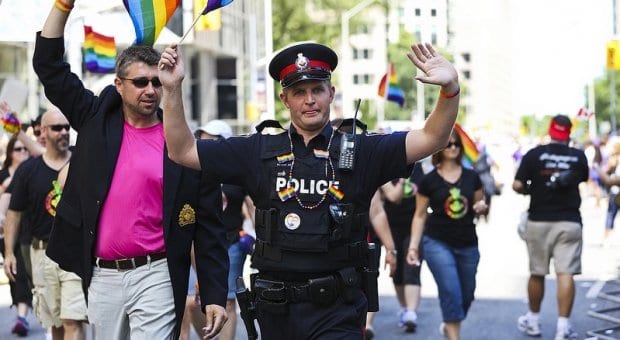
Left to right: Acting staff superintendent Debra Preston (Toronto), Chief Paul Cook (OACP president), Kyle Kirkup and Andre Goh launch the report. Credit: Xtra file photo
The Ontario Association of Chiefs of Police recently tabled Canada’s first provincewide study of best practices in policing for the LGBT community in order to help the province’s police services address the community’s needs and concerns.
The 80-page report, “Best Practices in Policing and LGBTQ Communities in Ontario,” covers such broad topics as sensitivity training, recruitment and internal support for LGBT officers, policy issues and ongoing community engagement. It was prepared by Kyle Kirkup, a lawyer and scholar at the University of Toronto’s Mark S Bonham Centre for Sexual Diversity Studies.
The report specifically recommends creating community liaison committees or discussion groups, campaigns to prevent hate crimes and youth bullying, guidelines and training for handling HIV-nondisclosure cases, training for LGBT issues around sexual assault and domestic violence, awareness that the differential age of consent for anal sex is unenforceable in Ontario, guidelines related to policing in women-only spaces, and trans-sensitive procedures for strip searches and incarceration. The report also calls for better data measurement related to LGBT issues, such as hate incidents and domestic violence.
Over the course of a year, Kirkup researched policies in place in all of Ontario’s police services, surveyed queer-identified staff and spoke with community organizations across the province.
Kirkup says he found differing levels of awareness of LGBT issues across the province.
“Sometimes what I’ve heard is, ‘We don’t have a large community here; should we be doing this?’ But what I’ve also heard is that sometimes this is where the most work needs to be done,” he says. “It’s particularly relevant for some of the centres that might not have thought through the issues.
“An example might be the police are called in to some kind of violence going on, and they don’t recognize that it’s a same-sex couple. They might not recognize it as domestic violence and not provide the resources they might need, as in counselling.”
But Kirkup says he was also pleasantly surprised by some of the innovative initiatives that police services around the province had created.
“[The Sudbury Police Service] said they’d heard from the transgender community that they need to do a better job of reaching out to them, and so they invited them to come in and lead a training session for officers,” Kirkup says.
The OACP commissioned the report in order to encourage police services to be proactive in involving the LGBT communities in policing.
“One of the goals we had with the document was to get the ball rolling in making your police service more inclusive to the LGBT community,” says Andre Goh, chair of the OACP diversity committee. “How do you make your police service more inclusive and approachable, so that if you don’t feel safe in the community, you can at least feel safe with the police?”
Goh says some of the negative experiences that have damaged the relationship between police and the LGBT community — such as the 1981 bathhouse raids or the 2000 Pussy Palace raid — have ultimately led to better policing.
“Here in Toronto, we’ve been fortunate in a sense that those horrible experiences have also been learning tools for the police services and officers,” he says.
Police services in BC, Alberta, Quebec, Nova Scotia and in the US have also contacted OACP for direction on LGBT issues in the wake of the “Best Practices” report, Goh says.
Kirkup says he hopes the report will lead to more positive relationships between the police and the LGBT community.
“It’s not going to be a panacea that overnight eradicates homophobia and transphobia from police culture, but it can hopefully start that dialogue,” he says.


 Why you can trust Xtra
Why you can trust Xtra


